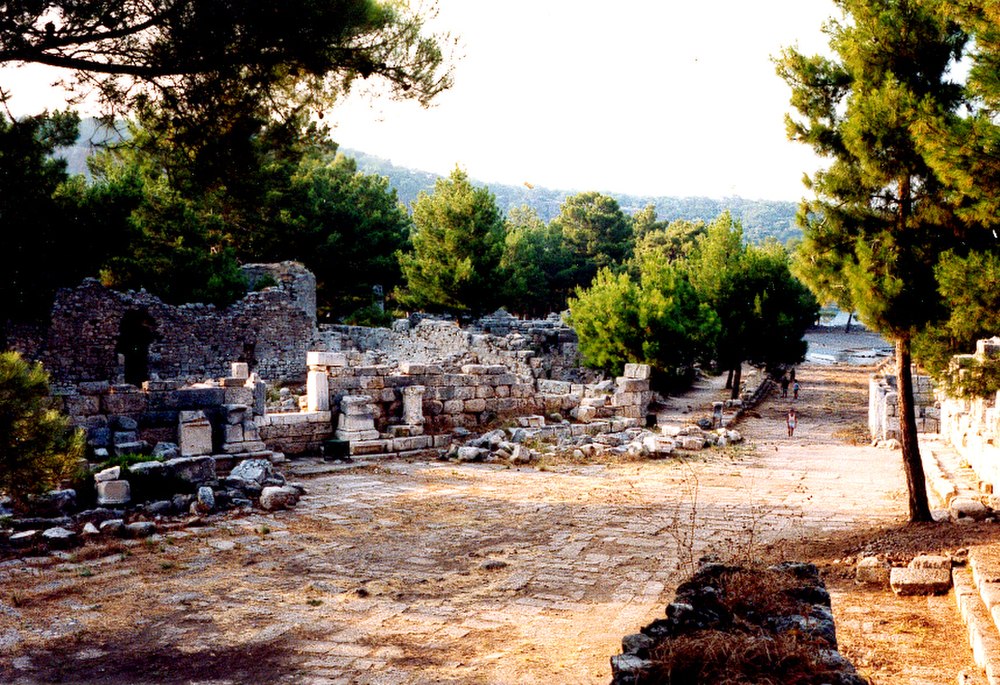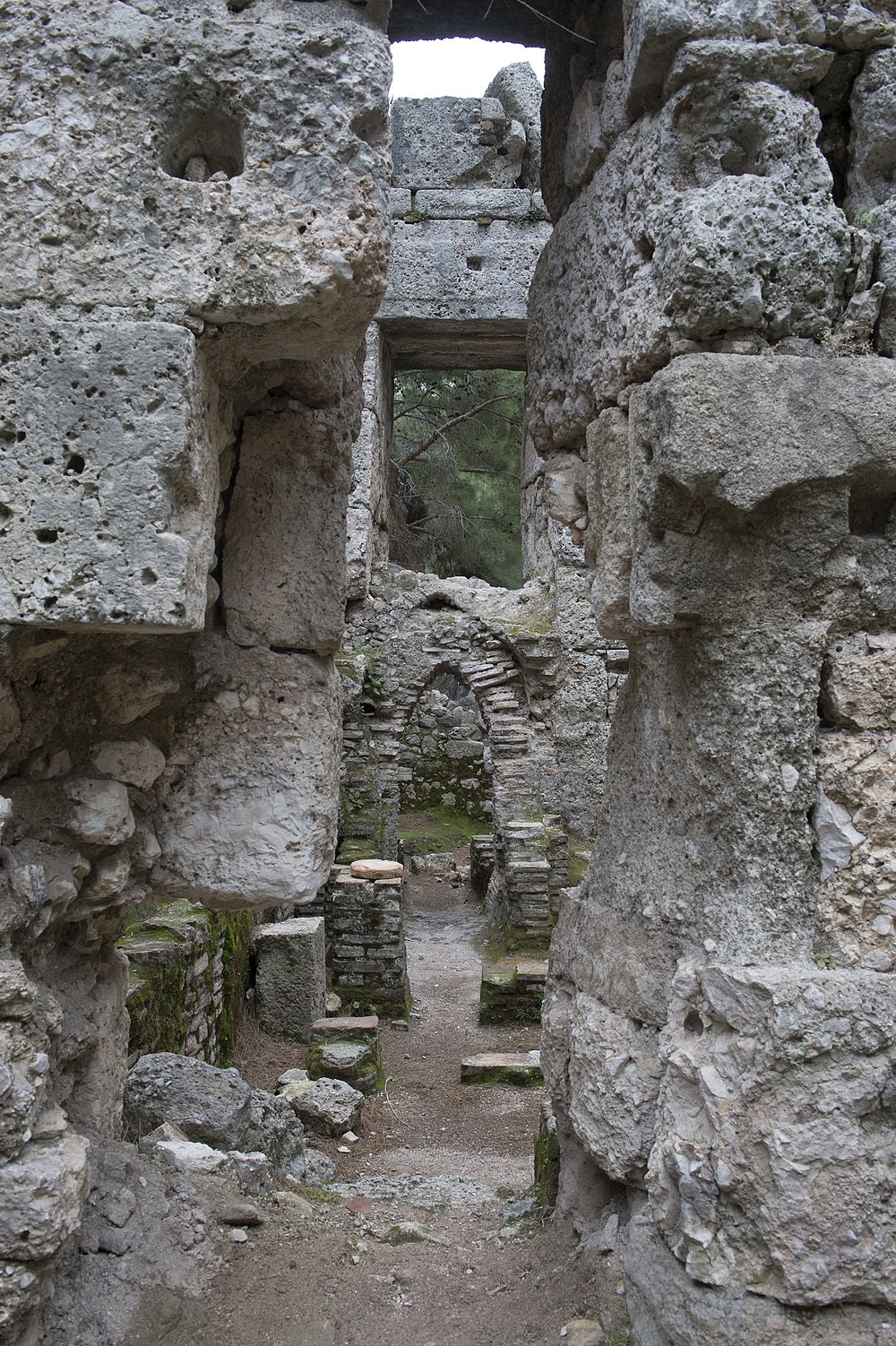Images from Wikipedia
The images seen below are from Wikipedia and were obtained under license,
which allows for their legal use on Wikipedia and other websites.
 Attribution: Dosseman, with CC BY-SA 4.0 license, original file:Phaselis_Big_Bath_5284.jpg , Wikipedia
Attribution: Dosseman, with CC BY-SA 4.0 license, original file:Phaselis_Big_Bath_5284.jpg , Wikipedia
One of many pictures I took at the Great Bathhouse, walking first along its edge looking down, then entering and seeing the several rooms and the heating system.
This is the caldarium.
 Attribution: Dosseman, with CC BY-SA 4.0 license, original file:Phaselis_City_Harbour_4761.jpg , Wikipedia
Attribution: Dosseman, with CC BY-SA 4.0 license, original file:Phaselis_City_Harbour_4761.jpg , Wikipedia
The northern of two harbours connected by the Main Street. One can detect some man-made materials in the water, and on the south side relatively much above, but don't expect more. I have seen the harbour refered to as "City Harbour", but other names are used.
 Attribution: Dosseman, with CC BY-SA 4.0 license, original file:Phaselis_City_Harbour_5300.jpg , Wikipedia
Attribution: Dosseman, with CC BY-SA 4.0 license, original file:Phaselis_City_Harbour_5300.jpg , Wikipedia
At the north side of the main street there is a bay, where there used to be a harbour, there are some remains. To the right one can see woodlands, that are on a hill that has an acropolis on top. A climb up there is (near?) impossible due to it being overgrown.
 Attribution: Dosseman, with CC BY-SA 4.0 license, original file:Phaselis_Entrance_Domitian_Agora_5310.jpg , Wikipedia
Attribution: Dosseman, with CC BY-SA 4.0 license, original file:Phaselis_Entrance_Domitian_Agora_5310.jpg , Wikipedia
Agora's would be open squares surrounded by shops, but what remains of the Domitian Agora (identified by an inscription) is heavily overgrown. Passing through here leaves you in woodlands.
 Attribution: Dosseman, with CC BY-SA 4.0 license, original file:Phaselis_Front_Tetragonal_agora_5359.jpg , Wikipedia
Attribution: Dosseman, with CC BY-SA 4.0 license, original file:Phaselis_Front_Tetragonal_agora_5359.jpg , Wikipedia
The notice indicates this (at least the space behind it) is the agora. From a very informative site I conclude this is the "Tetragonal Agora, thanks to the dedicatory inscription we learn that it was constructed during the Hadrianus Period and dedicated to the emperor." It is across the street from the small bath and theatre.
 Attribution: Dosseman, with CC BY-SA 4.0 license, original file:Phaselis_Hadrian%27s_Gate_5314.jpg , Wikipedia
Attribution: Dosseman, with CC BY-SA 4.0 license, original file:Phaselis_Hadrian%27s_Gate_5314.jpg , Wikipedia
From the Phaselis project site I quote: "A magnificently constructed gate separates the South harbour and the main street at the entrance of the harbour. This single-arched, square-shaped monumental gate rising above two pylons and decorated with lion feet profiled elements on four sides was erected in honor of Emperor Hadrianus’ visit to the city during his eastern expedition." Elsewhere I read the gate was maybe just renamed for his visit.
 Attribution: Dosseman, with CC BY-SA 4.0 license, original file:Phaselis_March_area_5368.jpg , Wikipedia
Attribution: Dosseman, with CC BY-SA 4.0 license, original file:Phaselis_March_area_5368.jpg , Wikipedia
A winding road from a higher main road leads to the ancient city at the sea. One can park there, and have a fine view of the hinterland, like this.
 Attribution: Dosseman, with CC BY-SA 4.0 license, original file:Phaselis_Theatre_5331.jpg , Wikipedia
Attribution: Dosseman, with CC BY-SA 4.0 license, original file:Phaselis_Theatre_5331.jpg , Wikipedia
In quite a good state (helped by the fact that the seats were dug out from a flanking hill, so earthquakes caused little damage) the Phaselis theatre is located at the Main Street, from which stept lead to it. The stage building had three stories. It is Roman in style, has 21 rows of seats and could hold about 1700 people.
 Attribution: Dosseman, with CC BY-SA 4.0 license, original file:Phaselis_march_2012_5298.jpg , Wikipedia
Attribution: Dosseman, with CC BY-SA 4.0 license, original file:Phaselis_march_2012_5298.jpg , Wikipedia
A notice indicating it was the Ana Yolu or Main Street). This 24-metre-wide ancient street runs through the middle of the city, from the ‘South Harbour’ to the ‘Military Harbour’. The main part of it has been conceived as a procession street, with four steps for the spectators on each side of the road. On the street’s left (in the West) lie the ‘Great Bathhouse’ and three agoras (the Commercial – or ‘Rectangular’ - Agora, the Agora of Domitian and the Late Roman agora); on its right (in the East) lie the Small Bath and the Theater. The 'Hadrian Waterway Gate' is on the southern end of the street.
Source: ‘Lycie’ – Cevdet Bayburtluoğlu & Personal visits (1989, 2006)
 Attribution: Dosseman, with CC BY-SA 4.0 license, original file:Phaselis_Big_Bath_5284.jpg , Wikipedia
Attribution: Dosseman, with CC BY-SA 4.0 license, original file:Phaselis_Big_Bath_5284.jpg , Wikipedia
One of many pictures I took at the Great Bathhouse, walking first along its edge looking down, then entering and seeing the several rooms and the heating system.
This is the caldarium.
 Attribution: Dosseman, with CC BY-SA 4.0 license, original file:Phaselis_City_Harbour_4761.jpg , Wikipedia
Attribution: Dosseman, with CC BY-SA 4.0 license, original file:Phaselis_City_Harbour_4761.jpg , Wikipedia
The northern of two harbours connected by the Main Street. One can detect some man-made materials in the water, and on the south side relatively much above, but don't expect more. I have seen the harbour refered to as "City Harbour", but other names are used.
 Attribution: Dosseman, with CC BY-SA 4.0 license, original file:Phaselis_City_Harbour_5300.jpg , Wikipedia
Attribution: Dosseman, with CC BY-SA 4.0 license, original file:Phaselis_City_Harbour_5300.jpg , Wikipedia
At the north side of the main street there is a bay, where there used to be a harbour, there are some remains. To the right one can see woodlands, that are on a hill that has an acropolis on top. A climb up there is (near?) impossible due to it being overgrown.
 Attribution: Dosseman, with CC BY-SA 4.0 license, original file:Phaselis_Entrance_Domitian_Agora_5310.jpg , Wikipedia
Attribution: Dosseman, with CC BY-SA 4.0 license, original file:Phaselis_Entrance_Domitian_Agora_5310.jpg , Wikipedia
Agora's would be open squares surrounded by shops, but what remains of the Domitian Agora (identified by an inscription) is heavily overgrown. Passing through here leaves you in woodlands.
 Attribution: Dosseman, with CC BY-SA 4.0 license, original file:Phaselis_Front_Tetragonal_agora_5359.jpg , Wikipedia
Attribution: Dosseman, with CC BY-SA 4.0 license, original file:Phaselis_Front_Tetragonal_agora_5359.jpg , Wikipedia
The notice indicates this (at least the space behind it) is the agora. From a very informative site I conclude this is the "Tetragonal Agora, thanks to the dedicatory inscription we learn that it was constructed during the Hadrianus Period and dedicated to the emperor." It is across the street from the small bath and theatre.
 Attribution: Dosseman, with CC BY-SA 4.0 license, original file:Phaselis_Hadrian%27s_Gate_5314.jpg , Wikipedia
Attribution: Dosseman, with CC BY-SA 4.0 license, original file:Phaselis_Hadrian%27s_Gate_5314.jpg , Wikipedia
From the Phaselis project site I quote: "A magnificently constructed gate separates the South harbour and the main street at the entrance of the harbour. This single-arched, square-shaped monumental gate rising above two pylons and decorated with lion feet profiled elements on four sides was erected in honor of Emperor Hadrianus’ visit to the city during his eastern expedition." Elsewhere I read the gate was maybe just renamed for his visit.
 Attribution: Dosseman, with CC BY-SA 4.0 license, original file:Phaselis_March_area_5368.jpg , Wikipedia
Attribution: Dosseman, with CC BY-SA 4.0 license, original file:Phaselis_March_area_5368.jpg , Wikipedia
A winding road from a higher main road leads to the ancient city at the sea. One can park there, and have a fine view of the hinterland, like this.
 Attribution: Dosseman, with CC BY-SA 4.0 license, original file:Phaselis_Theatre_5331.jpg , Wikipedia
Attribution: Dosseman, with CC BY-SA 4.0 license, original file:Phaselis_Theatre_5331.jpg , Wikipedia
In quite a good state (helped by the fact that the seats were dug out from a flanking hill, so earthquakes caused little damage) the Phaselis theatre is located at the Main Street, from which stept lead to it. The stage building had three stories. It is Roman in style, has 21 rows of seats and could hold about 1700 people.
 Attribution: Dosseman, with CC BY-SA 4.0 license, original file:Phaselis_march_2012_5298.jpg , Wikipedia
Attribution: Dosseman, with CC BY-SA 4.0 license, original file:Phaselis_march_2012_5298.jpg , Wikipedia
A notice indicating it was the Ana Yolu or Main Street). This 24-metre-wide ancient street runs through the middle of the city, from the ‘South Harbour’ to the ‘Military Harbour’. The main part of it has been conceived as a procession street, with four steps for the spectators on each side of the road. On the street’s left (in the West) lie the ‘Great Bathhouse’ and three agoras (the Commercial – or ‘Rectangular’ - Agora, the Agora of Domitian and the Late Roman agora); on its right (in the East) lie the Small Bath and the Theater. The 'Hadrian Waterway Gate' is on the southern end of the street.
Source: ‘Lycie’ – Cevdet Bayburtluoğlu & Personal visits (1989, 2006)




















